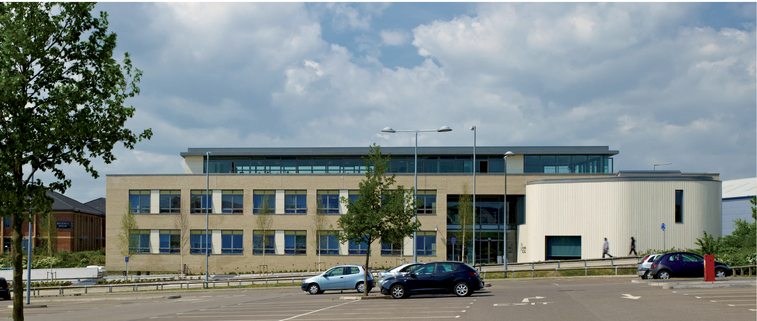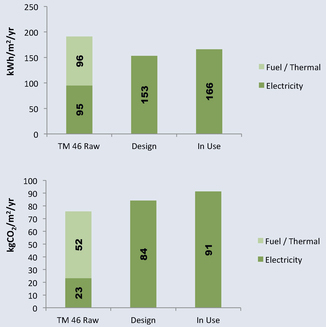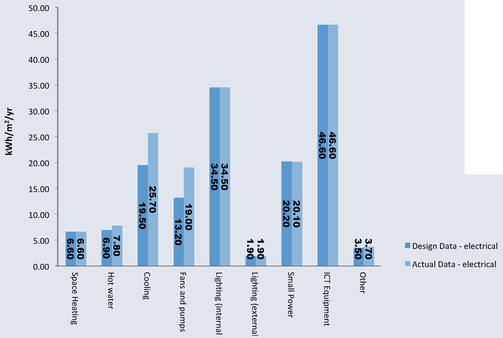CASE STUDY 2
Greenfields House
Braintree

Overview
Greenfields Community Housing took over Braintree Council’s homes in November 2007 following a tenant and leaseholder ballot. The building brings all of the organisation’s activities together in a productive working environment combined with social and exhibition spaces and a community hub. The brief for the project was developed by a working group that included residents, resident board members, staff and the designers.
Design approach
Located on a sloping brownfield site on the edge of an existing retail park, the new building consists of three storeys of narrow-plan office floors and a timber-clad public hub that shares the entrance and reception space with the office (Figures 01–03).


01 Entrance hall with artwork mounted on acoustic panels


03 External view of main entrance: ‘Every aspect of this beautiful building screams non-bureaucratic, non-standard, non top-down and everything about “people and community”. I helped change the group’s mind on the choice of brick; who am I? A tenant, what do I know? Every time I pass the building I smile ... empowerment.’ (Leigh Jones, tenant representative)
The building is organised to allow its exhibition and public meeting areas to be used outside of normal business hours, reflecting Greenfields’ aim to promote health, education and well-being and provide more than just housing services (Figure 04).
The working group championed the project’s aims and challenged the designers on the detailed aspects of the brief and the environmental strategies needed to deliver a flexible and comfortable environment.
The group expressed a strong preference for windows that could be opened, a degree of control and self-management of the internal environment, and a studio-like atmosphere in the office spaces. The light and airy internal atmosphere is appreciated by staff, and any lingering associations with their local-authority origins have been dispelled.
Environmental design
The building has a highly efficient envelope, high thermal mass provided by an exposed concrete frame, and good natural daylighting. Three ground-source heat pumps provide all the heating and cooling for the offices, reducing the energy use. Passive design measures reduced the need for cooling, which is only provided to IT rooms and community rooms where the occupancy can be high.
In winter fresh air is introduced by a displacement system through the office floor plenum. The air is pre-heated by an extensive underground labyrinth and a heat exchanger within the air-handling unit. In the summer unwanted heat can be purged in periods of hot weather by using a night-time ventilation system that pulls fresh air across the exposed concrete surfaces. High-level ventilators, operated automatically by the building management system (BMS) allow air to pass above cellular offices. This arrangement ensures that the cross-ventilation and purge ventilation will be effective even if the office space is divided into a more cellular arrangement. Only one of the three heat pumps needed to be reversible to provide cooling, and this was sized with the intention to future-proof the building against a warmer climate (Figure 05).

04 Internal view: foyer to community hub (‘my space’) with art inspired by residents

05 Heating diagram: grant funding for heat pumps led to a decision to make the building all electric

06 Ceiling coffers under construction
The building’s exposed concrete soffits act as a visual feature of the office space, as well as playing a role in its passive thermal systems. Circular recesses 1,200mm wide and 25mm deep were formed in the concrete using plywood discs with chamfered edges. Large circular pendant lights are suspended from the centres of these recesses, complementing the design by subtly accentuating the recesses, and fulfilling the need to have direct and reflected light in the office environment (Figures 06 and 07).

07 Circular ceiling recesses: note uplighting, deisgned to accentuate chamfer on coffers

08 External view

09 Thermal image: heat loss around high-level actuators (highlighted red) – probably caused by service wear of actuator mechanism (not returning vent against air seals)
Monitoring and post-occupancy feedback88
The BUS (Building Use Studies) methodology survey was undertaken in the summer of 2012 and energy monitoring continued through 2013 and 2014, though hampered at first, as with many of the Innovate UK building performance evaluation (BPE) studies (as discussed in Essay 2), with difficulties setting up the building’s sub-metering to give informative readings.
Overall the performance evaluation confirmed that the first design objective, to make an efficient building fabric, had been successful. The heating demand for the building was less than predicted in the Part L design calculations and the overall energy use was close to the predictions, representing a considerable achievement.
Somewhat surprisingly the users frequently remarked that the building was too warm, even in the winter months. Thermal imaging work confirmed that the insulation had been installed consistently well, but small infiltration losses were noted around the high-level window vents (see Figures 08 and 09) to the top floor and in a concealed location behind the main staircase. The stair walls have several layers of construction, and heat losses could be through the voids behind the plasterboard (a thermal bypass) or directly by a thermal bridge. The cause was not pursued, as tracing this relatively minor loss would have involved some intrusive and disruptive investigation. The losses observed around the opening vents could either be because of deterioration of the casement weather seals, or more likely because the automatic actuators are not returning the windows to the closed position firmly against these seals. The high winter temperatures were managed with adjustments to the heating controls and reprogramming of thermostats in different areas.
Although the passive elements were generally performing to a high standard the BPE study raised more serious questions about the efficacy of the controls and the accuracy of information being reported to the user’s management team. The handover of the completed building was rushed because of the termination of a lease on Greenfields’ previous offices. Individual elements of the services were commissioned and signed off by subcontractors, but it seems that the commissioning of the overall controls and the description of their operation was compromised. Added to this, some false savings were made in the ‘value engineering’ processes during the two-stage tender. The functionality of the BMS was reduced, and the computer interface reporting sub-meter outputs and the status of the different services components was removed. With a relatively inexperienced facilities management team and with little convenient access to the BMS, Greenfields were effectively flying blind in the first year of operation. A proposed Soft Landings approach to handover was also abandoned, as the finish date began to override other aspects of completion.

10 ‘Doorknobs’ is a five-metre-high artwork made up of 864 porcelain doorknobs fired with images, each one depicting a detail from the memories of a local resident. Displayed prominently in the welcoming foyer of the building, the artwork is one of a number commissioned from local artists.
Frustratingly for the monitoring team the BUS user survey did not coincide with the measurement and data collection process, so it was not possible to confirm anecdotal evidence of overheating by measurement. However, some very important feedback emerged from the occupiers’ survey, confirming misunderstandings about the building operation and revealing some deficiencies in the ‘trial and error’ approach to system optimisation. An example was the intended summer ventilation regime. The building’s mechanical ventilation system, which supplies tempered air through floor displacement grilles, is supplemented by automatic high-level vents and low-level user-operated vents. The automatic vents are also part of a night-time cooling strategy and are controlled by the BMS to open when external nighttime temperatures are lower than internal temperatures. Some of the users had been advised not to open low-level vents themselves, as these would interfere with the operation of the automated systems, disabling a simple local temperature and ventilation control.
The night-purge system also experienced teething problems similar to those encountered at the Woodland Trust (see Case Study 1), with erratic control of the night vents in high winds or when it was raining. The system was shut down by the BMS or manually overridden whenever blowing paper triggered a movement detector or alarm. Weather sensors would take a long time to reset after the cessation of rainfall, restricting the intended air movement.
Other changes made by the client were implemented hastily by the building’s management, and with the benefit of hindsight could have been better thought through with help from the designers. The decision to install anti-glare film across all windows, even though the glare problems were only localised, led to an increased use of artificial lighting in the office spaces, contrary to the designers’ intention to maximise daylighting.
Many staff considered the artificial lighting to be too bright. Lighting levels have been reduced in some areas by de-lamping luminaires. Such over-specification is not uncommon. The design aimed to achieve a ‘maintained’ illuminance of 600 lumens per m2 – an industry norm, promoted in the main by funding institutions.
Another intervention was the introduction of a dedicated split DX-type cooling unit to the comms room. The reversible ground-coupled heat pump dedicated to cooling the room had periodically cut out, jeopardising Greenfields’ operations. The replacement is both energy and carbon intensive, but as the monitoring team also failed to identify the fault (thought again to be a controls issue) this intervention seems justified. These two changes and the introduction of an air-curtain over the entrance doors have increased the overall energy usage, and carbon emissions, which are already high because of the all-electric heating systems.
Conclusions
Overall the lessons from Greenfields show that seemingly simple mixed-mode buildings still need well-designed and manageable controls. Savings to the control system and BMS proved to be false economies. In addition misunderstandings about how to operate the building, especially where seasonal changes require different behaviours, were caused by the hurried handover.
This project showed that the simple BUS user survey, supplemented by effective sub-metering, revealed many areas for improvement. This demonstrates that expensive monitoring is not necessarily essential to help get the best out of building performance.
Overall the client, designers and construction team did well to deliver a building that performs close to the expected design performance. With a low heating demand the decision to use heat pumps (subsidised through the Low Carbon Building Programme) may be justified, though the pumps and their controls require specialist and expensive maintenance.
Each member of Greenfields Community Housing’s residents and employees values their new ‘home’, as they all played a part in its conception, design and completion. The building has been very well looked after since its occupation in 2009 (Figures 11–12).

11 Internal view: office space and shared kitchen

12 South elevation: it will be some time before trees help with solar shading

13 Energy and carbon graphs

14 Energy by end use graph
